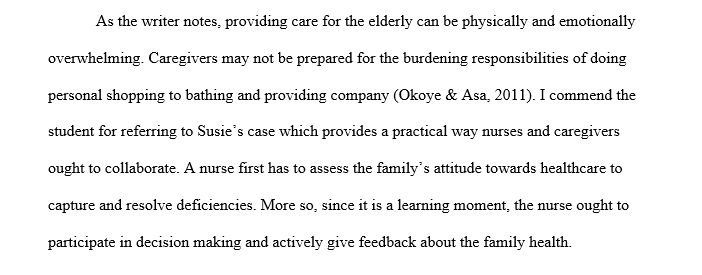Type of informal caregiving arrangement
In the United States, giving care to an aged parent is the commonest type of informal caregiving arrangement. Available data shows that almost 24 million families are involved with this. (Views on Aging, n.d). Caring for an aged parent can be so challenging that if not handled appropriately, it may lead to serious psychiatric concerns like mental stress, depression or even suicide for the caregiver.(Kikuzawa, 2016). This student believes that caregiver burnout and stress may be triggered by factors ranging from assisting a chronically ill family member with Activities of Daily Living (ADL) to dealing with a drastic change in the day to day activities of the caregiver. In the case under review, Susie and her entire nuclear family are about to experience a big change occasioned by the enormous responsibility of caring for Mrs. Jones, her mother.
The nurse caring for Susie’s family must evaluate the attitude of the entire family to healthcare and the promotion of health. The nurse must also ensure that his or her life or way of rendering care would provide a practical example for the entire Susie family. The nurse must in conjunction with Susie’s family, seek to improve identified deficiencies in the healthcare practices of the family. The nurse must help the family to take healthcare decisions which protect the development and welfare of the patient. The nurse must when practicable, be a veritable part of the family decision-making process. The nurse should endeavor to provide feedback to the family in order to reinforce safe and positive healthcare decisions. The nurse should provide necessary resources including but not limited to materials on disease prevention to protect Mrs. Jones and other family members. Finally, the nurse should also act as an intercessor between Susie’s family and other healthcare professionals. (Edelman, Kudzma & Mandle, 2014)
Health education is the most important intervention which can enhance health promotion for Susie’s family. Health education in this instance should include the expected role reversal between Susie and Mrs. Jones and its ramifications for not just Susie and Mrs. Jones but other members of their family as well. The envisaged education in this instance will prepare Susie and other family members for the mental challenge of taking care of a sick and incapacitated family member. This will in turn, minimize caregiver stress and burnout. Incorporating other members of Susie’s family into the education process will also enable the nurse teach each family member ways in which the presence of Mrs. Jones in the family may affect such member. It will enable family members to voice and address any concerns. The nurse must teach Susie and other family members to as much as possible, involve Mrs. Jones in the decision-making process of her care. Mrs. Jones should be allowed as much independence as practicable in the circumstance. It has been suggested that involving the patient in decision making processes of such patient’s care and encouraging patient autonomy results in better outcomes for the patient. (Baas, 2012). Teaching Susie and other family members will enable them acquire skills like medication administration, repositioning Mrs. Jones to avoid pressure sores, giving Mrs. Jones bed baths when necessary and other nursing skills
The family structural theory is concerned with family composition and make up. It is also concerned with the relationship among the members of the family in contrast with the relationship with individuals outside the family. (Mantelo Cecilio, Sturião dos Santos & Silva Marcon, 2014.) The nurse can use the structural theory by seeking to involve family members who are closest to Mrs. Jones in her direct care. This is because it has been suggested that one of the ways of preserving an aged family member’s dignity and trust is by putting her direct care into the hands of family members with whom the patient shares the closest relationship.( (Mantelo Cecilio, Sturião dos Santos & Silva Marcon, 2014.)
On the other hand, the developmental theory focuses on the development through several stages by members of a family and the transition which occurs with such development. (Edelman, Kudzma & Mandle, 2014). Using this theory, the nurse may decide to apportion roles in the care of the patient based on the developmental stages of family members. Younger members of Susie’s family who have no stable means of income or jobs may get more roles in the care of Mrs. Jones. As they grow and transition into bigger responsibilities, the roles of such family members may mutate in accordance with their transition.
References
Baas, L. S. (2012). Patient- and family-centered care. Heart & Lung: The Journal of Acute and Critical Care, 41(6), 534-535.
Edelman, C., Kudzma, E., Mandle, C. (2014). Health promotion throughout the life span, 8th Edition. 174, retrieved from https://pageburstls.
Kikuzawa, S. (2016). Social Support and the Mental Health of Family Caregivers: Sons and Daughters Caring for Aging Parents in Japan. International Journal of Japanese Sociology, 25(1),
Mantelo Cecilio, H. P., Sturião dos Santos, K., & Silva Marcon, S. (2014). Calgary model of family assessment: Experience in a community service project. Cogitare Enfermagem, 19(3), 493-501
Views on Aging: How Caring for an Aging Parent Influences Adult Daughters’ Perspectives on Later Life. (n.d). Journal of Adult Development 20(1), 46-56.
Solution preview for the order on type of informal caregiving arrangement

APA